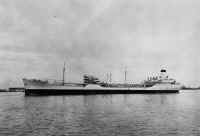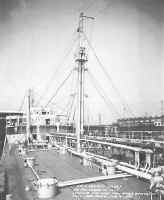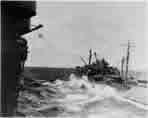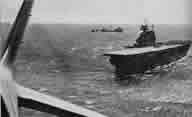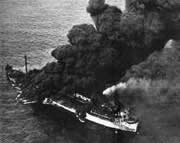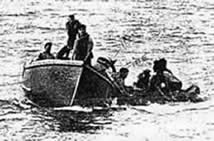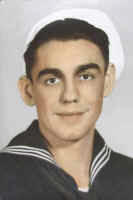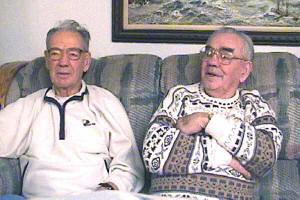The U.S.S. Neosho (AO-23) |
This section of my website is dedicated to the men who served on the oiler U.S.S. Neosho (AO-23) during World War II, including my uncle, Fireman 3rd Class, Bill Leu (1922-2003).
Construction of the U.S.S. Neosho began in June of 1938 in Kearny, New Jersey, and she was launched on April 29, 1939. At that time, the 553-foot long ship was the largest oil tanker in the world. Four months later, it was commissioned by the U.S. Navy in Norfolk, Virginia, and was officially named the U.S.S. Neosho. The Neosho, like other Navy oilers during WWII, was named after a river in the U.S. It was the second ship given that name, the first U.S.S. Neosho being a gunboat that operated on the Mississippi River during the Civil War. After being commissioned, the U.S.S. Neosho sailed through the Panama Canal to the Puget Sound Naval Yard at Bremerton, Washington, where it was converted to a U.S. Navy ship. In July of 1941, five months before the United States entered World War II, it was ready for service. My uncle, Bill Leu, at age 19, signed onto the Neosho in Bremerton that July just before it During World War II, the U.S.S. Neosho, like other Navy oilers, had two important missions:
In the early years of World War II, the U.S. Pacific Fleet had very few tankers. Therefore, because of their role as "floating gas stations," the Neosho and the handful of other Navy tankers were often the most precious ships in the Pacific Fleet, frequently surrounded and protected by the other ships during maneuvers. During its service with the U.S. Navy, the Neosho refueled patrolling fleets, transferred fuel from the mainland to the newly-established Pacific Fleet headquarters at Fierce Action at Pearl Harbor
That month, the U.S. Navy decided to relocate its Pacific Fleet from San Diego, California to The next morning, at 7:55 a.m., the Neosho had almost finished unloading its tanks when, as my Uncle Bill told me later, "all hell broke loose." Waves of Japanese planes suddenly attacked and mercilessly pummeled the U.S. Pacific Fleet, sitting idly at anchor. During a slight lull in the battle, the Neosho, one of the first ships at Pearl Harbor that morning to get under way, headed for safety on the Oahu mainland and dodged bombs and torpedoes while shooting down at least one Japanese plane. The Neosho was the only ship berthed on "Battleship Row" that terrible morning which was not damaged, and Bill, at his battle station with the 3-inch gun on the bow,
Above left: Pearl Harbor, Hawaii about 8:00 a.m. on December 7, 1941. The U.S.S. Neosho (right) sits at the Ford Island dock in "Battleship Row." Several torpedo wakes and shock waves are visible in the water, and the U.S.S. California (far right) is oozing oil. The U.S.S. West Virginia has just been hit and the U.S.S. Oklahoma is starting to list. The U.S.S. Arizona (far left) would explode moments later, instantly killing 1,177 men. Above center: The U.S.S. Neosho (right) at about 8:30 a.m. An awning, erected for Sunday morning services, covers the bow of the U.S.S. California (left), which is listing and straining at its lines. The U.S.S. Oklahoma lies capsized behind the Neosho. This was just before Captain John Phillips ordered the Neosho's lines cut. Above right: By about 9:00 a.m., the Neosho (circled) was still backing but was beginning to swing its bow around. Counter-flooding kept the U.S.S. California (left) from overturning and it settles in the mud. The overturned U.S.S. Oklahoma and smoking U.S.S. Maryland lie behind the California. The Battle of the Coral Sea
Simply put, before the Battle of the Coral Sea, the U.S. Navy had encountered almost nothing but defeat, while afterwards it encountered almost nothing but victory. The Neosho played an important role in the Battle of the Coral Sea, first fueling the American fleet and then acting as an unwitting decoy. On May 7, 1942, Japanese dive-bombers, searching for the main American fleet, discovered instead the Neosho and its escorting destroyer, the U.S.S. Sims, mistaking the flat-topped Neosho for an American aircraft carrier and the Sims for a cruiser. These ships had been left behind in a supposed safe area while the rest of the American fleet had sailed ahead looking for the Japanese fleet. During a relentless attack by 62 Japanese planes, the Burning and immobilized, the Neosho began listing sharply in the choppy seas. Afraid that the Neosho would capsize, Captain John Phillips ordered the crew to prepare to abandon ship, but the message got garbled and dozens of men immediately jumped into the water. Many of those drowned while others, including my Uncle Bill, piled into the three motorized whale boats that slowly circled the ailing ship. Dozens more clambered onto liferafts that slowly drifted away from the Neosho, most of whom were never seen again. While the Japanese planes were attacking the Neosho and Sims, they had barely missed spotting the bulk of the U.S. fleet, including the vital carriers Lexington and Yorktown. Had the Japanese planes not spotted the Neosho and Sims, they could well have found the two American carriers. Incidentally, at the same time that the Neosho was being attacked, American planes from these carriers were busy sinking a Japanese aircraft carrier.
Above left: The U.S.S. Neosho (right) refueling the aircraft carrier Yorktown in the Coral Sea, about May 2, 1942. This was five days before the Neosho was attacked by Japanese dive bombers. Above right: The Yorktown (right) and Neosho (center) from the rear of a U.S. torpedo bomber (TBD) that has just taken off. This was just before the Battle of the Coral Sea. The small ship on the horizon to the right of the plane's tail fin is the destroyer U.S.S. Sims. This is the only photo that Drifting Alone Despite the battering it had suffered, the Neosho refused to sink, buoyed by her partly-emptied tanks. The deck of the listing ship, however, was a mess. Half of the men were burned or wounded and almost everyone was covered with diesel oil. The men, including Bill Leu, patiently waited in the hot sun for three days without knowing what had happened in the battle, and had almost abandoned the Neosho when they were spotted by a scout plane. The next day, May 11, they were rescued by an American destroyer, the U.S.S. Henley. After the surviving 123 men were safely aboard the Henley, the destroyer tried to sink the Neosho so that the Japanese wouldn't find her. The ailing tanker was stubborn, though, and it took two torpedoes followed by 146 shells to put her under. Finally she began to sink, stern first, and many of the Neosho's crewmen wept from the Five days later, another American destroyer, the U.S.S. Helm, picked up four more survivors of the attack several miles away. These were the only survivors of 68 Neosho crewmen who had jumped into rafts and lashed them together shortly after the attack, certain that the Neosho was on the verge of sinking. The group of 68 men had drifted for nine days in the All tolled, only 111 of the 293 men on the Neosho and 13 of the 252 men onboard the Sims survived the attack. In other words, of the 545 men serving on both ships before the Battle of the Coral Sea, 124 survived while 421 men perished. Had the Neosho been a warship, its saga -- including its unique role at Pearl Harbor, the
Above left: This is the last known picture taken of the U.S.S. Neosho (the bow is to the left). Above right: Five days later, on May 16, the destroyer U.S.S. Helm discovered four men in a raft. These were the only survivors from a group of 68 men who had drifted away from the Neosho shortly after the attack on May 7 (the Helm's whaleboat is on the left and the Neosho's raft is on the right, partly submerged). The four men had floated on the raft for nine days without food or water and were in critical condition. Shortly after being rescued, two of the four men died. Interview With Bill Leu I'd always wanted to interview my Dad and my Uncle Bill together, but unfortunately the circumstances that led to this otherwise uplifting event were tinged with sadness. Earlier that fall, my father had been diagnosed with cancer and in mid-November, the hospice nurse told my Dad that he probably had only a week left to live. After the nurse left, I asked my Dad what he would like to do in the short time that he had left. He said only one thing: "I want to see my brother Bill." During their entire lives, my Dad and Bill were best friends, so it was no surprise that my father's final request was to visit with his older brother one last time. The next morning, I drove my Dad to Seattle where he spent the whole day with Bill and his family. During the visit, I videotaped an interview with my Dad and Bill, during which I asked them about growing up in Seattle in the 1920s, about the Great Depression, and about their experiences in Bill obliged me and spent 20 minutes talking about his combat experiences on the Neosho. As I learned later, this was the first time Bill had told anyone these stories. His wife and daughter, who sat nearby listening to him describe his experiences, were hearing many of these stories for the very first time. Bill had kept these painful memories to himself for 60 years and his eyes welled with tears as he remembered the friends he lost that afternoon in the Coral Sea, and of the valiant effort of the Neosho's staunch defender, the U.S.S. Sims. I've included the interview on these webpages so that others can hear his description of the battles. I've posted the video interview for readers with broadband access and the audio version for readers with dial-up access. I've split the interview into two sections: My father and his brother Bill had an emotional but fulfilling visit that day and my father passed away shortly afterwards. To everyone's surprise, Bill, who had appeared to be in good health, passed away suddenly six months later, in May of 2003. Although I was saddened that both my
Above left: My uncle, Bill Leu, Fireman 3rd Class, in 1941. Bill served on the Neosho during its entire active service, from July 1941 until May 1942. Above right: My Dad (left) and my uncle Bill Leu (right) during their interview in 2002. Information and images obtained from: |
